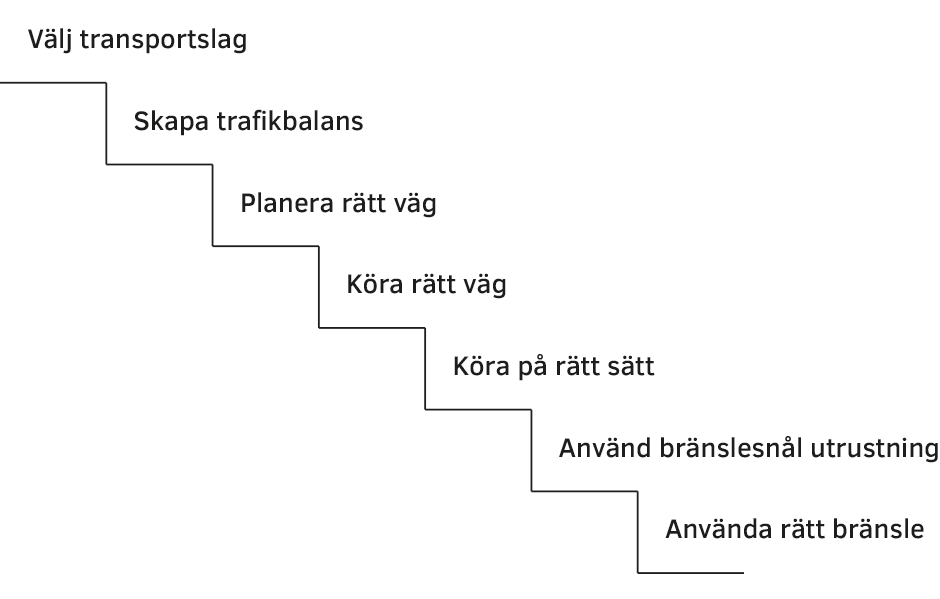With a desire to achieve status as the most respected logistics company in Europe for unpackaged food we are constantly developing new solutions. With new technology and increasingly more knowledgeable and more committed employees, we reach new heights
The insight that FoodTankers´biggest environmental impact, the combustion of diesel at transports, goes hand in hand with the profitability of the company, has led to our environmental staircase to reduce fuel costs and environmental impact. The staircase should be cleaned from top to bottom for the best effect.

Choosing means of transporting
The FoodTankers Group works with tank transports but is also on its way with intermodal transports. This means that we use tank containers which then are transported with different means of transporting, usually a combination of train, ferry and truck.
We discuss with several of our customers to find routes that may be possible to move to intermodal traffic. The environmental aspect is, in most cases, obvious, but other practical factors are often a limitation, for example longer delivery time, reduced flexibility, reduced control over the goods and an increased risk for delays. In practise, the described limitations must be balanced by a corresponding lower price.
The FoodTankers-Group believes that intermodal transports will increase significantly ahead, mostly because of reduced costs but hopefully also through an increased environmental awareness. Intermodal transports is a priority growth area for FoodTankers.
Creating traffic balance at sale
Reduced environmental impact and improved economy is best achieved by avoiding vehicles driving empty. Every driven kilometer without a load effects the environment negatively without any customer benefit. The basic market- and sales work for FoodTankers is to analyze and process the market to find customers and destinations which reduce the proportion kilometers driven without a load. An important part of the work is to try to change conditions of existing customers to facilitate for example common loading. The work is long term and much controlled by geographical conditions. Access to unique models and tools makes the analysis possible. On a daily level our planners try to achieve the corresponding effect by buying and selling transports on the spotmarket.
Planning right
Our trafficleaders´task is to plan so that current transport missions can be performed at the same time as the cost for performing them is minimized. In practise this means that the total mileage to perform current customer order must be minimized at the same time as the promised time for loading and unloading must be kept, a not entirely simple equation.
Centralized planning is one of the cornerstones to achieve a good plan. At a decentralized planning the risk of suboptimization and that empty vehicles meet on the roads is big. Since ten years, all planning is done in Karlshamn
Optimizing the planning in a dynamic way to minimize unnecessary driving is the next step we´re working with. Today the planning is done manually with the support of administrative systems which gives a good, but not optimal, result. Along with a Danish actor we run a project to implement their optimization system in our business.
Optimization algorithms are created to achieve the shortest practical mileage in view of, among other things, loading-unloading places and times, current positions of the vehicles, road networks, washing facilities, ferries, vehicle restraints and type of product.
Driving the right way
An optimal planning can quickly be destroyed if the vehicles don´t drive the planned route. At FoodTankers the trafficleaders are responsible for the drivers running the planned way and that loading and unloading is done at the promised time. Today they can follow and communicate with the trucks in real time via the vehicle system Transics. To follow up that we drive the right way we measure real driving distance and compare with a theoretical distance from the map program.
Proper driving
Our drivers are trained in ”economical driving” – Eco Driving. The follow up is done through Transics, where we, in real time, get information not only about fuel consumption but also about the drivers´driving behaviour such as speed, braking, acceleration, freewheeling, idling and so on.
Using fuel-efficient equipment
Even the best of drivers must have a good equipment well maintained to keep the fuel consumption per driven kilometer at a reasonable level. Switch to new vehicles gives the biggest effect on the environment but maintenance also effects the fuel consumption.Since many years FoodTankers pumps with nitrogen. Correct tire pressure means a lot to the rolling resistance and thereby the fuel consumption. Nitrogen has the positive feature not to leak through the rubber to the same extent as common air in tyres does. FoodTankers has used nitrogen for many years and sees a big difference. The nitrogen tyres have to a much bigger extent the correct pressure than tyres with common air.
Using the proper fuel
Fom August 2016 FoodTankers´ Norden fleet is driven on 100% HVO (hydrogenated vegetable oils). HVO 100 consists of 100% diesel, renewable and free from fossil with lubricity additives. The product can be described as a copy of common fossil diesel. The diesel is delivered from Circle K to our station in Stilleryd. Driving on pure HVO means that we reduce our carbon dioxide emissions up to 90% in comparison with fossil diesel. HVO is free from palm oil.
A big advantage with HVO in comparison with RME is that you don´t have to make any modifications on the vehicles and you don´t have to increase the service intervals on the vehicles.

